One of the most terrible thing that could happen to your tank mates is that they could get sick and bereaved of disease that you were unsuspected of how to cure.
Various diseases can occur to the lovely ones in your tank, which as a result can follow up to more drastic consequences.
Contents
Common Aquarium Fish Diseases – Symptoms & Cure
This article enlists common aquarium fish diseases and measures to prevent those diseases in order to keep your fish healthy and give them a longer lifespan.
1. Fin Rot
Fin Rot is peculiar among Tropical Fish, especially those who are kept in a freshwater aquarium. Apparently, this disease is easy to witness because its physical indication is specific.
The fishes in the aquarium have flush fins. Fishes with Fin Rot have rough and gradually diminished fins.
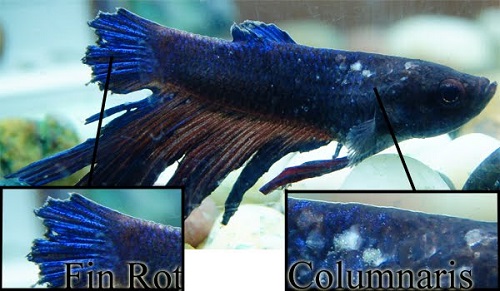
Physical Signs:
The most evident physical sign of fin rot is white dots on fins, fins edge gradually become rough and the base of fins gets inflamed. Fin Rot can be identified in its advanced stages. i.e, the pieces of tail and fins start to fray. If not taken proper preventive measures this disease can become deadly.
Cause:
There are various factors that can lead to fin rot, such as environmental and overcrowding. Environmental; the disease creeps in when the fish become accent with the environment. In most cases, the poor quality of water and low water temperature are driving factors for fin rot. Overcrowding the tank, feeding bad food or improper handling of fish are also causes of fin rot.
Treatment:
Bacteria cause fin rot. Thus an antibiotics like metronidazole for fish could be useful in the treatment of fin rot. The disease occurs when the fish comes under stress with something in the habitat, treatment should include proper cleaning of the fish tank and water change on regular basis. Decide a schedule for fish food, feeding fish with high-quality vitamin is far better than overfeeding.
Prevention:
- Maintain proper water parameters.
- Feed fish with healthy food.
- Keep the environment clean.
- Reduce overcrowding.
2. Swim Bladder Disorder
Swim bladder disease, also known as swim bladder disorder is a common infection in aquarium fish. This ailment is most commonly seen in Goldfish and Bettas, but it can happen to any species of fish. In this disorder fish sinks in the aquarium and struggles to rise up.
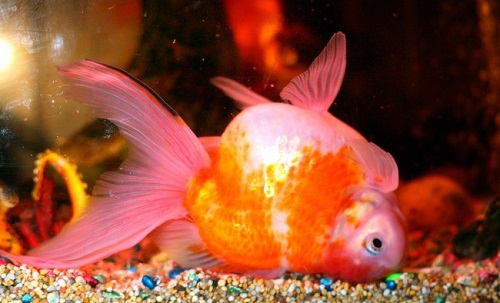
Physical Signs:
Swim Bladder Disorder is more of a group of symptoms(syndrome) than a specific disease. Particularly when a fish is not able to rise up in an aquarium or starts to swim abnormally is more likely to be reported as swim bladder syndrome. The fish then would not be able to swim and control air.
Cause:
Following are the causes of this disease:
- Birth Defect.
- Bacterial Infection.
- Swallowing air from the surface of the tank.
- Compression of the organs from the surrounding.
- Constipation.
- Fermentation of food.
Treatment:
It is evident that the eating habit of fish is the root reason for Swim Bladder Disorder. Constipation is caused by the quality of food or swallowing air while eating food, or eating the wrong type of food.
Following are the measures that could be effective:
- Reduce the level of water.
- Do not feed fish for 3 days.
- Hand-feed the fish during treatment, if needed.
- Onc can increase the water temperature to 80.
- Use of water salt will be helpful in reducing the stress of fish.
As mentioned earlier, in this syndrome fishes are not able to swim normally. Reduction in water level would help the fish to move around easily. Do not feed the fish for 48 hours, then feed the fish with boiled peas, boiled peas or frozen peas are ideal as they have proper consistency. Peel the skin of the peas and then serve the peas to the fish.
If the syndrome still persists after this treatment, then the problem is not due to enlarged stomach. The fish may show sign of bacterial infection leading to loss of appetite and clamped fins. Treatment with a broad spectrum antibiotic can be useful.
Follow these steps and your fish would hopefully show signs of improvement.
Prevention:
- Soak food before feeding.
- Do not overfeed the fish.
- Change the water on regular basis.
- Keep the water temperature suitable for fish.
3. Body Flukes
Gyrodactylus are a group of parasites commonly known as “Flukes”. This very broad group of parasites attacks many species of Tropical Fish. The bacteria attach themselves to gills or skin of the fish and causes great damage to the fish. These parasites are microscopic in stature and cannot be seen with naked eye.
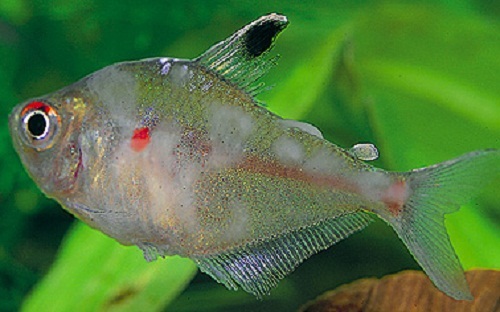
Physical Signs:
Following are the signs:
- Redness on the skin.
- Gills moving rapidly.
- Eaten away gills or fins.
- A layer of mucus covers the skin.
- Scratching against the objects by affected fish.
Cause:
Unwanted change in the habitat is the root cause of this disease. Poor quality of water is one of the factors responsible for such change in fish. Also, overcrowding increases the stress level of fish, making them more vulnerable to such disorder. Flukes are present in an aquarium but remain inactive until a certain level, if the fish comes under stress then the outbreak of these parasites occur.
Treatment:
This disease is contagious, i.e, it will pass on to the other tank mates. Firstly, isolate the affected fish from others so that the parasite won’t multiply. Treat the fish with Tetra Parasite Guard(a drug used to treat fish with body flukes). Conduct change of water between treatment to ensure the fish with clean water habitat.
Prevention:
As mentioned the fish get sick due to stress and poor water condition. Make sure, that the fish is stress-free and change water on regular basis. If the outbreak occurs then immediately treat the infected fish with an antibiotic. One can use formalin too.
4. Dropsy
Dropsy is rather more of a symptom than a disease. It is an indication of one or more underlying disease. Dropsy takes place when excessive fluid buildup in the body cavity of the fish. If not cured in the earlier stages then this disease becomes incurable in the later stages.
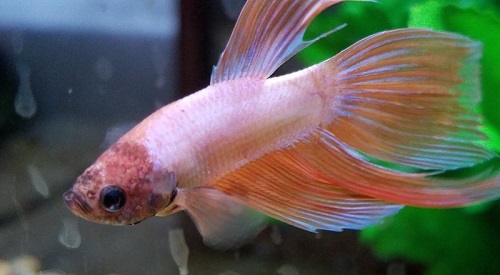
Physical Signs:
The primary sign of dropsy is bloating, swelling caused by assembly of fluids, along with the tissue and the body cavity. Swelling uncovers in the belly, but this is not the case every time, other symptoms such as eyes bulge out, anus becomes swollen. Behavioral change such as lethargy of the fish changes, the hiding all the time and staying at the bottom of the aquarium.
Cause:
There could be several reasons for dropsy, the primary one being is, affected by negative bacteria which lead to infection. Poor quality of water is also an issue for dropsy. Secondly, the temperature of the water is also a factor for negative bacteria, the temperature of water vary from the breed of the fish. Lastly, improper nutrition or bad food can also result in dropsy.
Treatment:
The treatment of this disease is not easy, however, if detected in the earlier stages dropsy could be cured. Firstly, salt treatment can be used to cure it. The thumb rule is to add 1teaspoon of salt per gallon of water. In addition to that food intake should also be taken care of. Drop some antibiotic in the tank.
Prevention:
It is more common among tropical fish, make sure the environment of the tank is suitable for the fish. Maintaining water quality is also a preventive measure to ensure fish are free from negative bacteria.
5. Ich
Considered as one of the most common diseases and known as the “White Spot Disease”, here white spots are protozoans which attach themselves to the fish, apparently, it looks like a white grain of salt. This disease impacts many fish including koi. Koi disease is especially dangerous for these fish.
The protozoa damage the skin and tissue as it enters the body of the fish.
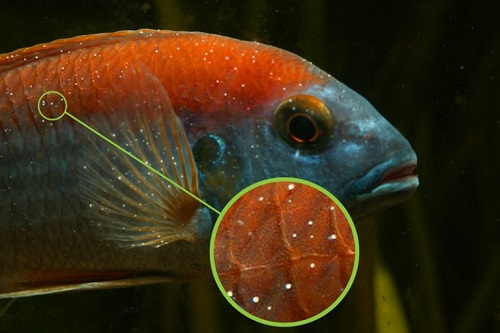
Physical Signs:
One can see white spots on the body as well as fins.
Cause:
Following are the causes of itch:
- Overcrowding.
- Increase in stress level.
- Dirty Water.
- Water Temperature.
- Diet.
- Incompatible tank inhabitants.
Treatment:
Treatment of fish includes; cleaning of water, providing proper nutrition, raising water to sufficient temperature(75-80 degree F). Ich is caused by termites, so if the temperature of the water is increased to sufficient level then the termites can be removed. If a fish is suffering from such disease, the fish should be isolated and should be treated with an antibiotic. Clean and vacuum the tank until the sign of ich is gone. Addition of aquarium salt to the tank can also be useful in such cases.
Prevention:
The following can be the prevention of Ich:
- Clean the water on regular basis.
- Always place new fish in a proper quarantine tank.
- Feed the fish with a variety of healthy food.
- Do not overstock tank.
The EndNote
Hope you guys enjoyed reading out our comprehensive article on the most common fish disease.
We believe that it will be helpful for all, to determine the disease among the fish and to save your loved ones from any illness.
Cheers!
